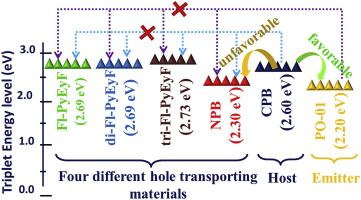Organic Electronics ( IF 2.7 ) Pub Date : 2020-01-11 , DOI: 10.1016/j.orgel.2020.105633 Deepak Kumar Dubey , Gintare Krucaite , Sujith Sudheendran Swayamprabha , Rohit Ashok Kumar Yadav , Dovydas Blazevicius , Jairam Tagare , Sudam Chavhan , Tsung-Chia Hsueh , Sivakumar Vaidyanathan , Saulius Grigalevicius , Jwo-Huei Jou

|
For an organic light-emitting diode (OLED), enhancing hole injection into the emissive layer for charge balance is a priority to achieve efficient device performance, while solution processing enables organic devices to be fabricated cost-effectively with a large area-size via continuous roll-to-roll manufacturing. However, a limited number of small molecules-based hole-transporting materials (HTMs) were reported with the solution process feasibility and high performance. Here, we demonstrate a series of low cost, efficient and solution processable small molecule HTMs, namely, 2,7-Di(4-fluorophenyl)-9,9-diethylfluorene (Fl-PyEyF), 2,7-Di(3,5-difluorophenyl)-9,9diethylfluorene (di-Fl-PyEyF) and 2,7-Di(2,4,6-trifluorophenyl)-9,9-diethylfluorene (tri-FlPyEyF), designed by using two fluorophenyl, difluorophenyl or trifluorophenyl fragments as common end capping groups with 9,9-Diethylfluorenes cores, respectively, for highly efficient OLEDs. The glass transition temperatures of the molecules were estimated to be higher than 80 °C, which can provide morphologically stable amorphous thin films. All the molecules possess good solubility in common organic solvents. Moreover, all the synthesized molecules have not only appropriate highest occupied molecular orbital energy levels for good hole injection ability, but also sufficient lowest unoccupied molecular orbital for electron blocking capability, adequate ionization potentials (6.15 eV) and suitable triplet energies, which make them suitable hole transporting materials. The current efficiency of a conventional iridium(III) bis(4phenylthieno[3,2-c]pyridinato-N,C-2՜) acetylacetonate based phosphorescent yellow OLED device increases from 40.2 to 61.0 cd/A, an increment of 51.7% by substituting the conventional HTM, N,N′-di(1-naphthyl)-N,N′-diphenyl-(1,1′-biphenyl)-4,4′-diamine (NPB), with the tri-Fl-PyEyF counterpart. These findings suggest that the reported materials can serve as potential molecular HTMs in solution-processed OLED.
中文翻译:

用于溶液处理的有机发光二极管的基于芴的非晶态空穴传输材料
对于有机发光二极管(OLED),增强空穴发射到发射层中以实现电荷平衡是实现高效器件性能的首要任务,而溶液处理使有机器件能够经济有效地通过连续制造以大面积尺寸制造卷对卷制造。然而,据报道,有限数量的基于小分子的空穴传输材料(HTM)具有解决方案的可行性和高性能。在这里,我们展示了一系列低成本,高效且可溶液处理的小分子HTM,即2,7-Di(4-氟苯基)-9,9-二乙基芴(Fl-PyEyF),2,7-Di(3, (5-二氟苯基)-9,9-二乙基芴(di-Fl-PyEyF)和2,7-二(2,4,6-三氟苯基)-9,9-二乙基芴(tri-FlPyEyF),使用两个氟苯基设计,二氟苯基或三氟苯基片段分别作为具有9,9-二乙基芴核的常见端基,用于高效OLED。估计分子的玻璃化转变温度高于80°C,可以提供形态稳定的非晶薄膜。所有分子在普通有机溶剂中均具有良好的溶解性。而且,所有合成的分子不仅具有合适的最高空穴占据分子轨道能级以获得良好的空穴注入能力,而且具有足够低的最低未占据分子轨道来实现电子阻断能力,足够的电离势(6.15 eV)和合适的三重态能量,这使其很适合空穴传输材料。常规铱(III)双(4苯基噻吩并[3,2-c]吡啶并-N的电流效率 基于C-2՜)乙酰丙酮的磷光黄色OLED器件从40.2 cd / A增加到61.0 cd / A,通过取代传统的HTM,N,N'-二(1-萘基)-N,N'-二苯基(1,1′-联苯)-4,4′-二胺(NPB),与三-F1-PyEyF对应。这些发现表明,所报道的材料可以在溶液处理的OLED中用作潜在的分子HTM。











































 京公网安备 11010802027423号
京公网安备 11010802027423号